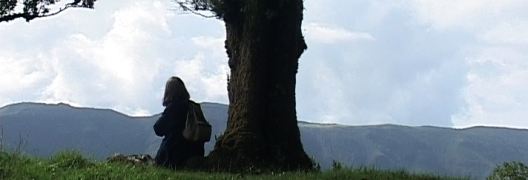
The painter Ana Marchand always felt a bit dislocated in her family. The love of art and travel, where did she get those from? As a young woman she saw a travel book written by her uncle Maurizio Piscicelli and finally understood. Catarina Mourão (Pelas Sombras, A Toca do Lobo, O Mar Enrola na Areia) follows Ana’s familiar and spiritual journey. Who was Maurizio? Who is Ana? The face of one, the face of the other. Reincarnation are the several lives we live.
—
When she was a little girl, Ana saw a book written by her uncle Maurizio in the living room bookshelf. It was a book that narrated his trip to Congo, with photographs that made people dream. Afterwards, she lost track of the book and of the mysterious presence of that relative with whom she would discover to have a lot in common. Already a grownup, Ana will look for traces of Maurizio’s life, as someone searching for a piece of himself. Mourão will accompany this journey with her cinema, itself also an art of the voyage, many times physical ones, and others interior and emotional ones, triggered by photographs and pieces of memorabilia. Ana e Maurizio is a delicate circuit of gazes, a journey through palimpsest and the superposition between times, generations and images. Catarina observes Ana that, in turn, tries to look at what her uncle saw in his trip to Benares, India. Everything changes and nothing changes, we feel the wind of Rossellini’s cinema, but also the crossover of other Catarina’s journeys (Pelas Sombras; A Toca do Lobo). (Carlos Natálio)
“The Hissing of Summer Sands” tell us about ‘The whistle man’, a sea-side character from the fascist years.

This is the story of Rui’s summer. Rui is a 13 year old boy who unlike all the other kids of his age doesn’t like football and fighting. He prefers to take refuge in a dream like world surrounded by dinosaurs and other animals from the forest. The film focuses on daily life in a poor housing estate in Porto and, in particular, on a group of children aged between 8 and 14. It follows their life outdoors always inventing new games. Parents are seldom home and children have space and freedom to create their own rules, games of power many times copying the models they know from home. This is a special summer: people are expecting the European Football Cup and the possible victory of the Portuguese team will raise the morale of a country in full recession. Kids and adults are hypersensitive, feelings go over the top. TVS are put outdoors and the games of the European cup are followed by children and adults as an almost religious ritual. The film focuses on daily life in a poor housing estate in Porto and, in particular, on a group of children aged between 8 and 14. It follows their life outdoors always inventing new games. Parents are seldom home and children have space and freedom to create their own rules, games of power many times copying the models they know from home.
Catarina Mourão has become one of the most delicate filmmakers in Portuguese cinema. The director now presents a portrait of another figure in Portuguese cultural history: her grandfather and writer Tomaz de Figueiredo. A film that gently unveils a family separated by his death through stories written in a country controlled by the fascist dictatorship. )
Come and see the painting I’m doing. A little bit large, it doesn’t fit in any museum. And so little, so very little, that all the people passing don’t even notice it. A canvas with a strange shape. What’s worth is that it isn’t necessary to stretch it. In itself it’s always ready to receive touches, winds, seasons, rain, sun…




